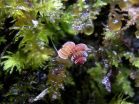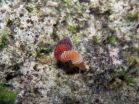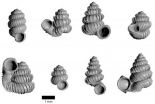(Press-News.org) A Malaysian-Dutch team of biologists have catalogued all 31 species of the tiny, but oh so pretty snail genus Plectostoma from West-Malaysia, Sumatra, and Thailand. Ten species are new to science, but some of those are going extinct as they are being discovered.
The study was carried out by PhD student Thor-Seng Liew of Naturalis Biodiversity Center in Leiden, The Netherlands, and three colleagues. Liew, who is on study leave from Universiti Malaysia Sabah, spent four years studying the distribution, shell shape, and genetics of these minuscule snails. He is still working on the species from Borneo, where Plectostoma is exceptionally diverse, but in the new paper, published in the open access journal ZooKeys, he first gets the species from the rest of Asia out of the way.
The snails are special for several reasons, says Liew. 'First of all, they flaunt all shell-coiling rules, by having very irregularly coiled and ornamented shells, making them look like microjewelry.' Liew used a so-called micro-CT-scanner, which produces three-dimensional X-rays of very tiny objects, to investigate the exact shapes of the shells. This allowed him to recognise 31 species, ten of which were new to science.
Another peculiarity is that they only live on limestone hills. In Southeast Asia, such hills are usually few and far between, and the snails that manage to colonise them are completely isolated. This, in turn, has caused a lot of "endemism": many Plectostoma species only occur on a single hill and nowhere else on earth.
But their endemism may also be their downfall, as Liew found out. Limestone hills are 'sitting ducks' for mining companies, and many are being quarried away for cement, taking their unique snails with them to their grave. One species, Plectostoma sciaphilum, is already extinct: its home was turned into concrete around 2003. Similar fates await at least six more species. One of these, P. tenggekensis (named and described in the new paper) occurs only on Bukit Tenggek, which the authors forecast to be completely gone by the end of 2014.
To highlight the plight of these unsung victims, the authors named several of the new species after conservationists and politicians who have fought for the preservation of Malaysia's endangered limestone hills.
INFORMATION:
Original source:
Liew T-S, Vermeulen JJ, bin Marzuki ME, Schilthuizen M (2014) A cybertaxonomic revision of the micro-landsnail genus Plectostoma Adam (Mollusca, Caenogastropoda, Diplommatinidae), from Peninsular Malaysia, Sumatra and Indochina. ZooKeys 393: 1. doi: 10.3897/zookeys.393.6717
Contact:
Prof. Dr. Menno Schilthuizen
Email: menno.schilthuizen@naturalis.nl
tel. +31-6-22030313
skype: mennoschilthuizen
Malaysian microjewels going extinct as they are discovered
2014-03-25
ELSE PRESS RELEASES FROM THIS DATE:
First stem cell study of bipolar disorder yields promising results
2014-03-25
ANN ARBOR, Mich. — What makes a person bipolar, prone to manic highs and deep, depressed lows? Why does bipolar disorder run so strongly in families, even though no single gene is to blame? And why is it so hard to find new treatments for a condition that affects 200 million people worldwide?
New stem cell research published by scientists from the University of Michigan Medical School, and fueled by the Heinz C. Prechter Bipolar Research Fund, may help scientists find answers to these questions.
The team used skin from people with bipolar disorder to derive the first-ever ...
Fewer children at risk for deficient vitamin D
2014-03-25
MAYWOOD, Il. – Under new guidelines from the Institute of Medicine, the estimated number of children who are at risk for having insufficient or deficient levels of vitamin D is drastically reduced from previous estimates, according to a Loyola University Chicago Stritch School of Medicine study.
The study, led by Holly Kramer, MD, MPH and Ramon Durazo-Arvizu, PhD, is published online ahead of print in the Journal of Pediatric Endocrinology and Metabolism.
New Institute of Medicine guidelines say most people get sufficient vitamin D when their blood levels are at or ...
Black markets for hackers are increasingly sophisticated, specialized and maturing
2014-03-25
Black and gray markets for computer hacking tools, services and byproducts such as stolen credit card numbers continue to expand, creating an increasing threat to businesses, governments and individuals, according to a new RAND Corporation study.
One dramatic example is the December 2013 breach of retail giant Target, in which data from approximately 40 million credit cards and 70 million user accounts was hijacked. Within days, that data appeared -- available for purchase -- on black market websites.
"Hacking used to be an activity that was mainly carried out by individuals ...
Lick's new Automated Planet Finder: First robotic telescope for planet hunters
2014-03-25
Lick Observatory's newest telescope, the Automated Planet Finder (APF), has been operating robotically night after night on Mt. Hamilton since January, searching nearby stars for Earth-sized planets. Every night the fully autonomous system checks the weather, decides which stars to observe, and moves the telescope from star to star throughout the night, collecting measurements that will reveal the presence of planets. Its technical performance has been outstanding, making it not only the first robotic planet-finding facility but also one of the most sensitive.
The search ...
Stink bug traps may increase damage to tomato fruits
2014-03-25
The invasive brown marmorated stink bug (Halyomorpha halys) is an important pest of fruits and vegetables. To counter them, some home gardeners use pheromone-baited traps that are designed to attract, trap, and kill them. However, new research from entomologists at the University of Maryland suggests that the traps may actually increase stink bug damage to tomatoes. The research will appear in the April issue of Environmental Entomology (DOI: http://dx.doi.org/10.1603/EN13237).
The researchers asked 15 gardeners to place stink bug traps at the ends of rows of tomatoes, ...
New method yields potent, renewable human stem cells with promising therapeutic properties
2014-03-25
New Rochelle, NY, March 24, 2014—The curative and therapeutic potential of mesenchymal stem cells (MSCs) offers much promise, as these multipotent cells are currently being tested in more than 300 clinical trials in a range of diseases. A new, easier, and more reliable way to make large quantities of highly potent MSCs could accelerate progress toward their use in regenerative medicine, as described in an article in Stem Cells and Development, a peer-reviewed journal from Mary Ann Liebert, Inc., publishers. The article is available on the Stem Cells and Development website.
Robert ...
The fundamentals of facial recognition
2014-03-25
When it comes to recognizing faces, humans are extraordinarily skillful. It's no surprise – after all, from the moment humans leave the womb, the infant brains already have a preference for faces, and over the course of a lifetime, the average person sees hundreds of thousands of faces.
Among scientists, however, the question of exactly how humans came to possess this amazing ability remains a divisive one, with some researchers claiming our extraordinary abilities result from the operation of mechanisms specialized just for faces, whereas others argue that recognition ...
Study finds gout drug may reduce risk of death
2014-03-25
(Boston)--In a recently to be published study in Annals of the Rheumatic Diseases, researchers have found the use of the drug allopurinol was associated with a reduced risk of death in hyperuricemic (gout) patients. The study, the first in a general population, has found the overall benefit of allopurinol on survival may outweigh the impact of rare serious adverse effects.
Researchers from the Section of Rheumatology and Clinical Epidemiology at Boston University School of Medicine (BUSM) contributed to this study.
Gout has been associated with an increased risk of ...
NOAA led study: Crude oil causes developmental abnormalities in large marine fish
2014-03-25
Crude oil from the 2010 Deepwater Horizon disaster causes severe defects in the developing hearts of bluefin and yellowfin tunas, according to a new study by a team of NOAA and academic scientists.
The findings, published in the Proceedings of the National Academy of Sciences on the 25th anniversary of the Exxon Valdez oil spill, show how the largest marine oil spill in United States history may have affected tunas and other species that spawned in oiled offshore habitats in the northern Gulf of Mexico.
Atlantic bluefin tuna, yellowfin tuna, and other large predatory ...
For neurons in the brain, identity can be used to predict location
2014-03-25
Cold Spring Harbor, NY – Throughout the world, there are many different types of people, and their identity can tell a lot about where they live. The type of job they work, the kind of car they drive, and the foods they eat can all be used to predict the country, the state, or maybe even the city a person lives in.
The brain is no different. There are many types of neurons, defined largely by the patterns of genes they use, and they "live" in numerous distinct brain regions. But researchers do not yet have a comprehensive understanding of these neuronal types and how ...






